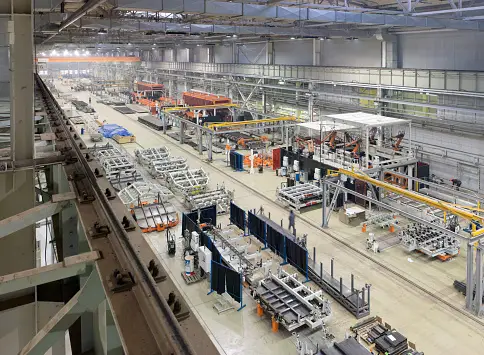Material Matters: Choosing The Right Equipment In Industrial Settings
In industrial settings, efficiency, safety, and quality are top priorities. Essential to these objectives is the selection of the right equipment for various tasks. This process goes beyond merely understanding how a machine operates. It calls for a deep understanding of the materials, like those provided by composite suppliers, and equipment in the industrial settings you’re working with and how they interact with different tools and machinery.
Table of Contents
Understanding your material and machinery
Industrial and construction settings commonly deal with a wide array of materials, from metals and plastics to woods and composite materials. Each of these comes with its unique properties, dictating specific processing requirements. Recognising a material’s hardness, density, ductility and tensile strength is the cornerstone of appropriate equipment selection.
For instance, a material’s hardness might dictate the type of cutting tool required. Hard materials might need a tool with a high cutting speed and superior wear resistance, while softer materials may not require as much. It’s also crucial to consider the finished product’s desired properties as they can influence the selection of materials and, consequently, the equipment used. Understanding these factors allows for efficient and safe material processing, reducing the risk of damage to both the material and equipment.
The role of equipment in industrial settings in material processing
The role of equipment in material processing cannot be overstated. Different tools and machines are designed to handle specific tasks and materials. If the equipment selected does not match the material or the task at hand, it can lead to suboptimal processing, resulting in poor-quality output. This mismatch can also damage the material, the equipment, or both.
Additionally, using inappropriate equipment can pose serious safety risks, leading to accidents in the workplace. Therefore, it is crucial to take the time and make the necessary investments in choosing the right equipment for the specific material at hand, impacting safety, cost-efficiency, and productivity positively.
Key factors in equipment selection
Several factors come into play when selecting equipment for material processing. The nature of the material and the task at hand are paramount, dictating the type of equipment required. But other factors, including cost, energy efficiency, safety features, ease of use, and the equipment’s lifespan, should also influence your decision.
Operational costs can be reduced significantly by selecting energy-efficient equipment, and safety features and ease of use can minimise the risk of workplace accidents and contribute to a smoother operational flow. An equipment’s lifespan should also be considered; more durable equipment, while possibly more expensive initially, might offer better long-term value.
Choosing the right bandsaw blade among equipment in industrial settings
Choosing the right bandsaw blade serves as a practical illustration of the equipment selection process. Different bandsaw blades are designed for various materials and tasks, each with its unique tooth pattern, size, and material. For instance, a bandsaw blade with larger, more aggressive teeth is typically for cutting wood. While a blade with smaller, finer teeth is suited to metals.
The selection of an incorrect bandsaw blade could lead to poor cut quality, increased material waste, and potential damage to the blade or machine. A deep understanding of the material you’re cutting and the desired cut type can guide the selection of the appropriate bandsaw blade, thus enhancing cut quality, operational efficiency, and extending the blade and the machine’s life.
Ensuring equipment longevity and maintenance
Appropriate equipment selection can significantly impact the longevity and maintenance schedule of the equipment. Using equipment for tasks beyond its design capacity can lead to premature wear and tear, necessitating more frequent maintenance or even premature replacement. On the other hand, appropriate equipment selection and usage, coupled with a regular and thorough maintenance schedule, can extend the equipment’s lifespan and ensure efficient and optimal operation over time.
This approach not only reduces operational costs but also minimizes downtime due to equipment malfunction or maintenance. It is worth noting that routine maintenance should not be considered a chore or an optional task. It’s an integral part of the equipment’s life cycle and contributes significantly to the equipment’s performance, safety, and longevity.
Equipment in Industrial Settings
Equipment in industrial settings refers to the machinery, tools, and devices perform various tasks and processes within manufacturing, production, and other industrial environments. These types of equipment handle heavy workloads, repetitive tasks, and sometimes hazardous operations to improve productivity, efficiency, and safety. Industrial equipment can vary widely depending on the specific industry and the processes. Here are some common types of equipment found in industrial settings:
- Manufacturing Machinery. This category includes equipment for manufacturing products, such as CNC machines, lathes, milling machines, stamping machines, and industrial robots. These machines shape, cut, bend, and assemble raw materials into finished products.
- Material Handling Equipment. Material handling equipment move, store, and transport materials within the industrial facility. Examples include forklifts, pallet jacks, conveyors, cranes, and hoists.
- Power Tools. Power tools, industrial machinery like drills, grinders, saws, and pneumatic wrenches are for various tasks such as cutting, drilling, grinding, and fastening.
- Industrial Furnaces and Ovens. Furnaces and ovens are for heat treatment processes, melting metals, and curing coatings or paints in industrial settings.
- Pumps and Compressors. Pumps move fluids, such as liquids or gases, within the industrial process. Compressors, on the other hand, increase the pressure of gases to perform tasks like pneumatic tools and process applications.
- Industrial Cooling and Refrigeration Equipment. Cooling systems manage the temperature of industrial processes and machinery to prevent overheating and ensure efficient operation.

11+ years strategic communications, marketing, and project management experience. I am a trainer at StarWood Training Institute, focusing on online courses for project management professionals.











